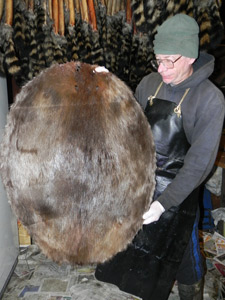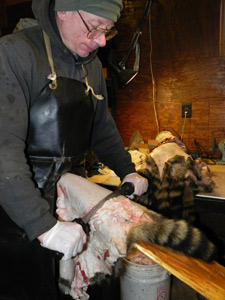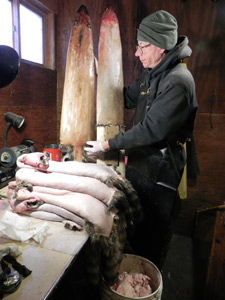ON THE TRAPLINE WITH ARNIE GROEHLER
![]()
In The Fur Shed
Once you have success in catching a few fur-bearing critters, then the real work begins: the fur handling (skinning, fleshing and drying). We American trappers like to catch things, but do not necessarily enjoy cleaning them. This is entirely different from our Canadian counterparts who are taught how to properly handle furs even before they set their first trap. It displays a philosophy of showing respect for the animals that we trap, by utilizing every part to its maximum potential.
Back in the "good-old-days" all you had to do was just drop your catch off in the sink and leave the wife and kids do the rest. Trust me when I say that those days are long since gone. Today you would be hard pressed to find a spouse who will even touch a dead raccoon, much less skin it. Good luck on getting her approval for you to do this in the basement or garage too. There is something about having dead animals in the house which brings out the worst fears in our partners. They envision hoards of fleas, germs and diseases coming from your "trophy catch." To us trappers there may be nothing more sweet than the aroma of mink or muskrat musk, or that special "fur smell" that comes from boxes of dried pelts. To our spouses these same smells are horrid and disgusting. All too often I have a hard time snuggling up to Mrs. G after a few hours of skinning, as she is constantly giving me the "sniff test" claiming to smell dead animal germs.
The best way to avoid these family problems is to have a fur shed, whereby you can properly handle your pelts, away from the constraints and complaining of the other family members. Fur sheds are a special place to trappers. We spend many hours in their confines processing the "golden nuggets" of our pursuits. After a long hard day checking traps you can get inside, next to the warm fire of a wood stove, surrounded by rows of beautiful furs; this becomes our "happy place."
 |
| A beaver pelt handled in an "open" method. |
Open Versus Cased Skinning
The first step to fur handling actually occurs once you remove the animal from the trap. Try and get the fur as clean as possible. Gently wash the critter in clean water to remove any dirt and vegetation. Then dry it off. The animals need to be completely dry before skinning. I will hang them up in rows in the fur shed, a place out of direct sunlight with good ventilation. A fan helps. Once they are dry and fluffy (usually overnight) use a fur comb to remove any burs or stickers tangled in the under-fur.
There are two methods of skinning: cased and open. "Cased" skinning is used for most of the fur-bearing animals, to include raccoons, muskrats, foxes, mink, etc. The initial cut goes from heel to heel of the hind feet. Then you cut around the back legs and base of the tail. Also make sure that you remove the tail bone and split open the tail for proper drying. Hang the animal up from a gambrel and proceed to peel the hide down towards the head being careful not to cut any holes in the pelt. Make cuts at the fur line of the front feet, through the cartilage on the ears, at the eyes and nose. Experienced trappers can skin an animal very quickly using this method. I used to skin muskrats for a local fur buyer at nights after school. It was not hard for me to skin a muskrat in less than one minute (faster if the Packers were playing that night and I wanted to get done before opening kick-off).
"Open" skinning is primarily used for beavers. The initial cut is right down the center of the beaver on the stomach side from the base of the tail to the chin. You then cut down the sides to the center of the back, and forward to the head area. When finished the pelt has an oval shape.
No matter which skinning method is used, make sure that your knives are razor sharp. I use a four inch "surgical" blade for the initial opening cut and a serrated blade for areas around the head of the animal. There is nothing more dangerous than a dull knife, and you actually risk more accidental cuts with the sawing/hacking that comes from a dull blade. Also insure that you wear rubber gloves while skinning. These animals can carry many diseases, and all it takes is a small cut to get sick. Trappers never wore rubber gloves years ago. As a result we were always getting sick from animal diseases. One of the more common was tularemia, commonly referred to as rabbit fever. Nearly every year I would get a bad dose of this flu-like illness while skinning muskrats. Today there are much more serious diseases out there, especially with raccoons. So always wear gloves when handling wild animals and then wash up good with anti-bacterial soap.
Fleshing
Once skinned, then the pelts need to be fleshed. Unlike hides (cattle/deer) which are salted, we flesh, stretch and dry furs. On some animals, like muskrats, only the large globs of fat and flesh come off, while on others, like raccoons and beavers, every bit of fat, flesh, gristle and membrane must be removed. This is done with a fleshing knife, which has two sides, one side is razor sharp which is needed to literally shave the gristle from the neck area of animals like raccoons, the other side is dull and is used to remove the lighter fat, which is pushed off using this blade. Just like skinning, fleshing requires some skill and experience to do it correctly.
 |
| Raccoon pelt on a stretcher, handled in a "cased" fashion. |
Stretching and Drying
When stretching furs, we do not actually pull and stretch the fur out as far as we can; it is more like "forming" it to a size and shape that the fur manufactures prefer. Each animal species has a certain set of dimensions. These sizes can vary according to the differences in animal size. A raccoon caught in Mississippi is only half the size of ones from Wisconsin. Raccoons from the U.P. of Michigan are even larger than those from Wisconsin, so they each require different size stretchers. Some of these regions will also acquire trade names. For example, a large mink of dark colored fur caught in any one of the Great Lake states will be referred to as a "Red River" mink, alluding to the Red River region of North Dakota which produces a mink of this size and color. Beaver that have dark colored fur tend to trace their genetics to a northern region, those with reddish fur to a southern origin, light-pale colored fur to that of the western states. The manufactures have identified the correct dimensions that work best for their equipment. We try and meet these standards, for maximum price.
Once the pelts are on the stretchers they are hung up to dry. A heat and air source like a fan and/or space heater all help to expedite the drying process. It takes about a week, depending on temperature and humidity levels to properly dry the pelts. They dry almost as hard as cardboard. Once dry, the pelts are taken off of the stretchers and collected on hangers or in boxes until ready for sale. In this state they are stable for several years. Although it is a good idea to keep them in cold storage to avoid moths and insect damage.
 |
| Raccoon pelts fleshed, stretched and dried, ready to be sent to the NAFA auction. |
The Special Moments
I have been spending many a late night getting my furs ready for the next auction. The previous night I would lay out 20 frozen raccoon pelts to thaw for this evening's fleshing/stretching. As the cold weather has set in, more and more of the "outside" wildlife has been getting into my fur shed. Most of the time these intruders are field mice looking for a warm shelter. On occasion I might have a raccoon or possum find the door open and reside inside for a day or two, until roused out. This past week I had a more unusual visitor. While busy fleshing raccoon pelts I noticed that one of the furs thawing out on the floor started to move around. My first thought was that I need to get more sleep, but then I saw something dragging the raccoon pelt away; it was a female mink. As I approached the mink it scurried away, up under my pile of duck decoys, only to reappear a few minutes later and start chewing on the raccoon pelt. How a mink would end up in my fur shed, a long way from their normal habitat, is a mystery to me. If I was a mink, taking up residence in a trapper's fur shed would be the last place to go, especially with fur prices as high as they are this year.






